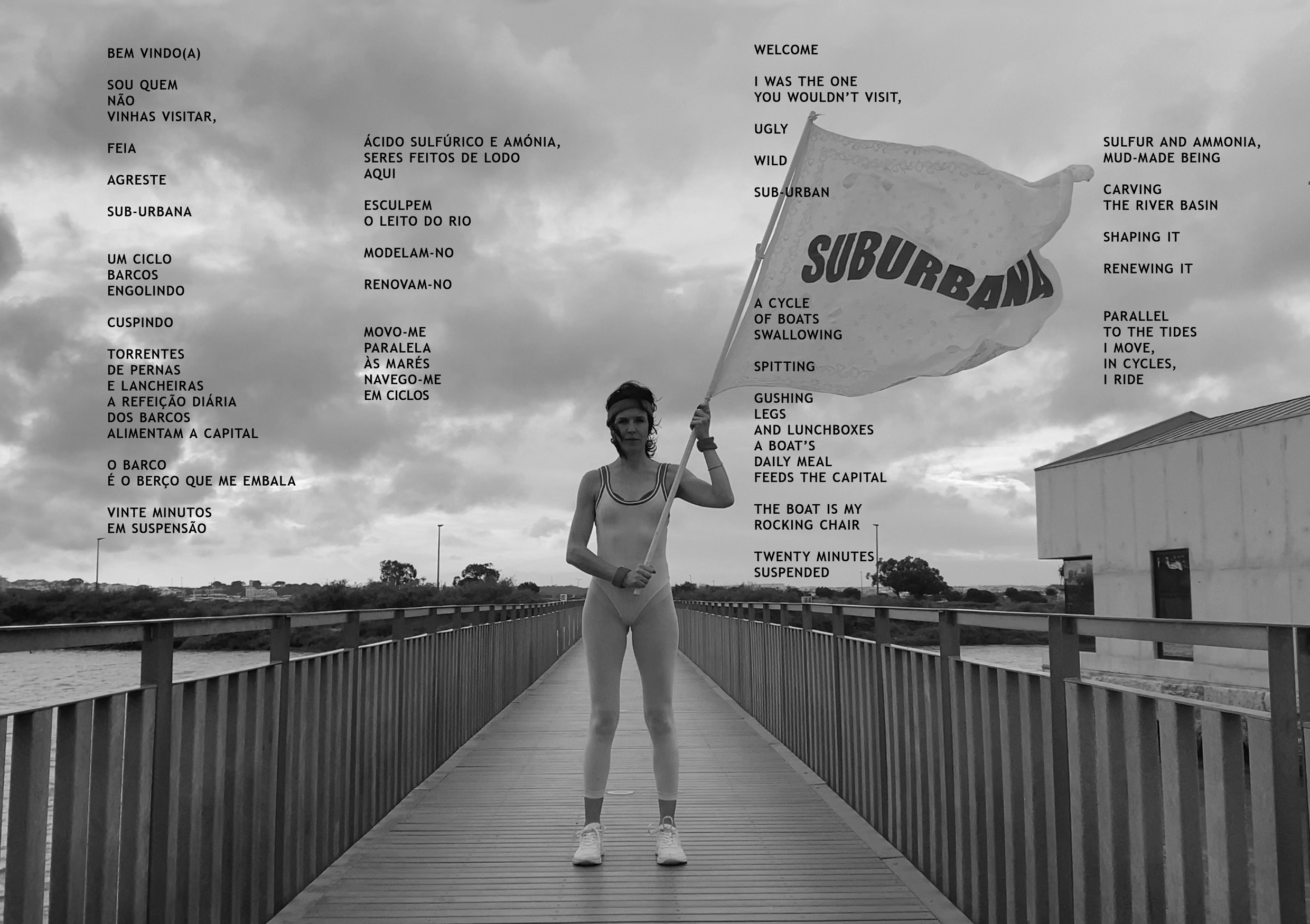PARALLEL CYCLES
14 MINS DIGITAL FILM
With multimedia installation and live performance
2022
Made with artists Ana Paxeco and Catarina dos Santos for TerritoryExpo/Barreiro.
Organised by Sluice Magazine and Pada, with Lisbon Art Weekend.
The film explores the symbiotic relationship between the suburban landscape of Barreiro and its inhabitants, both human and non-human. Separated from Lisbon by the Tejo River, Barreiro exists within a complex estuary that embodies a blend of industry, urban life, and wilderness. This project was developed in collaboration with local artists Ana Paxeco and Catarina dos Santos.
As part of the Territory Expo festival, Parallel Cycles was presented as a multimedia installation. We gathered weeds and discarded items from around the exhibition site, transforming them into a garden set against Ana’s drawings. The evening also featured live performances by Ana and musician-poet Catarina dos Santos, with the film projected onto the façade of the Moinho Pequeno building.
The project draws inspiration from Barreiro’s urban nature—often viewed as degraded or limited compared to pure wilderness and to the polished cityscape of Lisbon. However, I embrace the idea that no hierarchy exists among beings. Urban nature, even when polluted, offers a unique source of inspiration. The weeds that thrive in the cracks of concrete are, in many ways, my masters of resilience; I feel more connected to them than to untouched wilderness.
Together with performer Ana Pacheco, I developed a character who advocates for healing and recognition, seeking to forge a humble yet profound connection with her territory of origin and the broader world. Ana’s body, like all human bodies, is intrinsically linked to the earth, also in this post-natural, polluted landscape. Her veins carry the same water as the river, and her lungs share the air with the trees. These thoughts have inspired our upcoming group project, Breath of a Stone. For this film, we incorporated industrial ruins and waste left behind by local fishermen, merging these environmental elements with Ana’s movements to create a collaborative performance. Ana’s son, Rui, also contributed his own performance, adding another layer to the work. The film frames its protagonists against the new architectural infrastructures that aim to reshape Barreiro’s public spaces, seemingly striving to create a pristine narrative for the muddy estuary of the Tagus. My feelings towards this aspiration for cleanliness are conflicted; while I respect the complexity of the transformations underway, my instinct is to empathize more with those who wildly resist, get lost in the way or thrive in the mud.
The film captures a series of Ana’s improvised performances, set against some iconic locations in Barreiro: Braamcamp natural/ex-industrial area, the surroundings of Moinho de Maré Pequeno, Copacabana Beach. Ana’s white costume reflects her sense of displacement, like a superficial and artificial skin, and her exhausting attempts to adapt to the changing landscape and its social impositions.
Catarina dos Santos crafted the words and sounds that give voice to Barreiro, weaving parallel stories of migration, invisible labour, and daily commuting. The rhythm of the film is carried by the boats that traverse the river, continuously transporting suburban commuters like Ana and Catarina to the capital.
Film excerpts (2 min each):
Catarina’s words for Parallel Cycles PT/EN:
TERRITORY EXPO Exhibition, Moinho Pequeno:



Multimedia exhibition tour ( 2.29 min ) :
“We live a 20-minute boat ride from the capital of Portugal, suburbian-Lisbon. Barreiro, a post-industrial town built by migrants, like other places in Lisbon’s south bank. We were the ones you wouldn’t visit, for it was too polluted and ugly. Now, the heavy chemical industry that built this town is gone; it has left enormous areas of a post-industrial apocalyptic landscape. Ruins are under the laws of natural cycles. Nature is taking over. Unexpected new migrants are appearing; bird species and river creatures came to the almost chemical-free environment. These extraordinary creatures, carried up by wind and currents, slowly adapt to the landscape without pretending to own it. At the same time, a new cycle took a definite shape – the overflowing cycle of people that work in the capital every day. A cycle that is built around social structure, the one that feeds the capital’s economy. Boats swallow and spit hundreds and hundreds of workers and students every day, with the river as their highway. The river Tejo unites and separates Lisbon and us inhabitants of Barreiro. Some Barreirense dream about a straight bridge connecting the two banks forever. We are looking for the interconnection of our ecological environment and the political consequences of social control. We observe the cycles of nature, which are not controlled by humans but deeply affected. And the cycles of migration that feed capitals with human labour. Since these human resources cannot inhabit the unaffordable city, they live in an eternal movement, a daily migration that has a specific expression. The river is rhythm, for the waves caused by the ferries, for the tides. We are surrounded by natural and artificial cycles, inducted by the institutionalization of space.
Specific locations reflect simultaneously local and global dynamics and carry a crossing of stories from different times, present physically and in its non-material possibilities. The sound that surrounds us daily generates a sonic idea of space and a myriad of associated emotions. Sound reveals space, and sound is time. Sound comes to reinforce the web of stories and interconnections from a specific place. Reinforcing its presence, its beauty in all dimensions, and reinterpreting collective memory, ever transforming. The original sound piece of Parallel Cycles encompasses the movement of the ferries connecting the two banks of the river, urban and suburban soundscapes.”
Film Stills:


